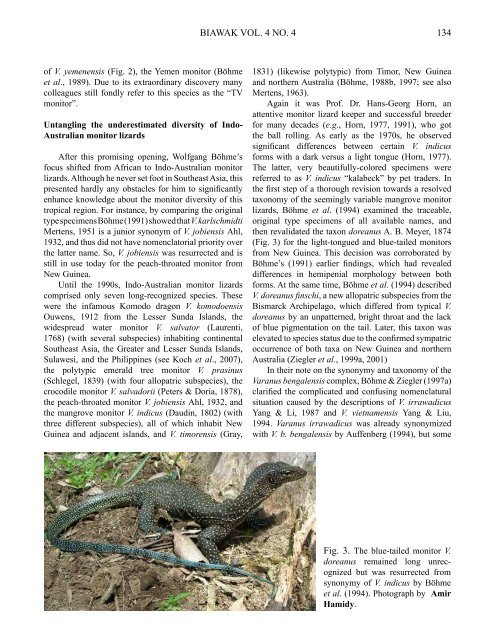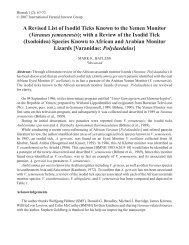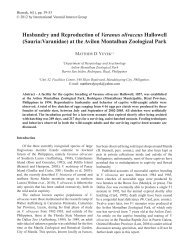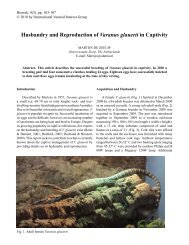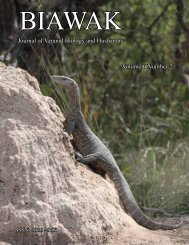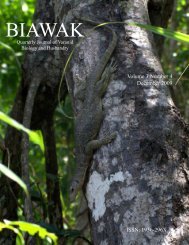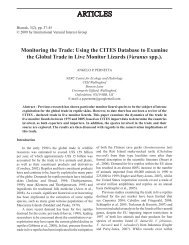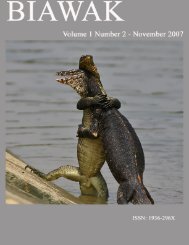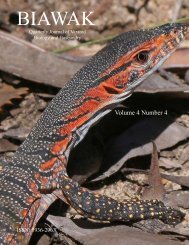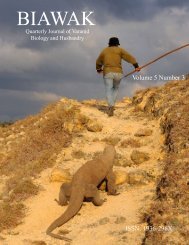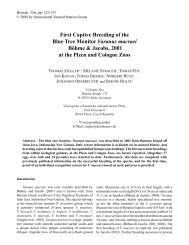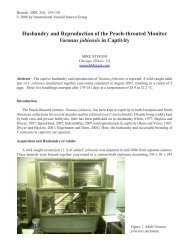BIAWAK - International Varanid Interest Group
BIAWAK - International Varanid Interest Group
BIAWAK - International Varanid Interest Group
- No tags were found...
Create successful ePaper yourself
Turn your PDF publications into a flip-book with our unique Google optimized e-Paper software.
<strong>BIAWAK</strong> VOL. 4 NO. 4 134<br />
of V. yemenensis (Fig. 2), the Yemen monitor (Böhme<br />
et al., 1989). Due to its extraordinary discovery many<br />
colleagues still fondly refer to this species as the “TV<br />
monitor”.<br />
Untangling the underestimated diversity of Indo-<br />
Australian monitor lizards<br />
After this promising opening, Wolfgang Böhme’s<br />
focus shifted from African to Indo-Australian monitor<br />
lizards. Although he never set foot in Southeast Asia, this<br />
presented hardly any obstacles for him to significantly<br />
enhance knowledge about the monitor diversity of this<br />
tropical region. For instance, by comparing the original<br />
type specimens Böhme (1991) showed that V. karlschmidti<br />
Mertens, 1951 is a junior synonym of V. jobiensis Ahl,<br />
1932, and thus did not have nomenclatorial priority over<br />
the latter name. So, V. jobiensis was resurrected and is<br />
still in use today for the peach-throated monitor from<br />
New Guinea.<br />
Until the 1990s, Indo-Australian monitor lizards<br />
comprised only seven long-recognized species. These<br />
were the infamous Komodo dragon V. komodoensis<br />
Ouwens, 1912 from the Lesser Sunda Islands, the<br />
widespread water monitor V. salvator (Laurenti,<br />
1768) (with several subspecies) inhabiting continental<br />
Southeast Asia, the Greater and Lesser Sunda Islands,<br />
Sulawesi, and the Philippines (see Koch et al., 2007),<br />
the polytypic emerald tree monitor V. prasinus<br />
(Schlegel, 1839) (with four allopatric subspecies), the<br />
crocodile monitor V. salvadorii (Peters & Doria, 1878),<br />
the peach-throated monitor V. jobiensis Ahl, 1932, and<br />
the mangrove monitor V. indicus (Daudin, 1802) (with<br />
three different subspecies), all of which inhabit New<br />
Guinea and adjacent islands, and V. timorensis (Gray,<br />
1831) (likewise polytypic) from Timor, New Guinea<br />
and northern Australia (Böhme, 1988b, 1997; see also<br />
Mertens, 1963).<br />
Again it was Prof. Dr. Hans-Georg Horn, an<br />
attentive monitor lizard keeper and successful breeder<br />
for many decades (e.g., Horn, 1977, 1991), who got<br />
the ball rolling. As early as the 1970s, he observed<br />
significant differences between certain V. indicus<br />
forms with a dark versus a light tongue (Horn, 1977).<br />
The latter, very beautifully-colored specimens were<br />
referred to as V. indicus “kalabeck” by pet traders. In<br />
the first step of a thorough revision towards a resolved<br />
taxonomy of the seemingly variable mangrove monitor<br />
lizards, Böhme et al. (1994) examined the traceable,<br />
original type specimens of all available names, and<br />
then revalidated the taxon doreanus A. B. Meyer, 1874<br />
(Fig. 3) for the light-tongued and blue-tailed monitors<br />
from New Guinea. This decision was corroborated by<br />
Böhme’s (1991) earlier findings, which had revealed<br />
differences in hemipenial morphology between both<br />
forms. At the same time, Böhme et al. (1994) described<br />
V. doreanus finschi, a new allopatric subspecies from the<br />
Bismarck Archipelago, which differed from typical V.<br />
doreanus by an unpatterned, bright throat and the lack<br />
of blue pigmentation on the tail. Later, this taxon was<br />
elevated to species status due to the confirmed sympatric<br />
occurrence of both taxa on New Guinea and northern<br />
Australia (Ziegler et al., 1999a, 2001)<br />
In their note on the synonymy and taxonomy of the<br />
Varanus bengalensis complex, Böhme & Ziegler (1997a)<br />
clarified the complicated and confusing nomenclatural<br />
situation caused by the descriptions of V. irrawadicus<br />
Yang & Li, 1987 and V. vietnamensis Yang & Liu,<br />
1994. Varanus irrawadicus was already synonymized<br />
with V. b. bengalensis by Auffenberg (1994), but some<br />
Fig. 3. The blue-tailed monitor V.<br />
doreanus remained long unrecognized<br />
but was resurrected from<br />
synonymy of V. indicus by Böhme<br />
et al. (1994). Photograph by Amir<br />
Hamidy.


